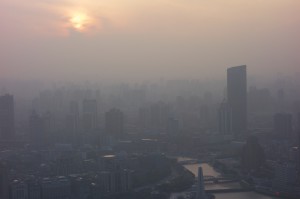No country in history has ever risen as a major industrial power without also rising as a leader in environmental damage, leaving behind a slew of environmental chaos that can take far longer and far more wealth to remedy than its rise to power took. The environmental damage caused by rapid industrialization of the world’s most populous nation, China – it had 1.351 billion people in 2012 – is so severe and far-reaching that its multifaceted repercussions are present not only domestically, but also internationally.
Jackie Liu is a 17-year-old girl who attends Second High School, which is attached to Beijing Normal University. This high school, one of the best in the nation and one that requires testing to gain admittance, is located in Beijing, China’s capital city and also one of the premier locations for air pollution and smog in the world. It is not an uncommon occurrence for Liu and her schoolmates to wear facemasks to protect themselves from breathing in the smog. Many students in her high school are native to Beijing and have grown up there their entire lives. The students joke that the sun often looks like the moon because it is so often enshrouded in smog said Liu in a phone interview.
In addition to China being the world’s largest source of climate-changing carbon emissions, the World Bank estimated in 2013 that 16 of the 20 most polluted cities are in China. Pollution has made cancer China’s leading cause of death, the Ministry of Health says. The same air pollution that hides the sun also is blamed for hundreds of thousands of deaths caused by respiratory diseases like lung cancer lower respiratory infections.
Liu, who has visited America and other developed countries, notes, “environmental problems such as air pollution so serious that it blocks out the sun might be considered devastating or catastrophic in America, but it is common in China. Of course the Chinese people are concerned, but at the same time this have become a part of our daily lives.” All of China’s industrial cities are plagued with the same problem as Beijing. The citizens rarely see the sun and when they do, it looks strikingly like the moon; blue skies are a rarity. Children are killed or sickened by respiratory diseases. The color of water in the rivers seems to reflect the sky: black, dull, and lifeless.
China is literally choking on its own success. The rapid rise in its GDP is unparalleled in history, but this growth derives from its equally staggering explosion in expanding industries that heavily rely on coal: the dirtiest, cheapest, most available source of energy. As a result, China’s fossil-fuel CO2 emissions have more than doubled since 2000 while other countries like America then started to invest in green technology such as wind turbines or sustainable buildings. At 1.92 billion metric tons of carbon in 2008, the People’s Republic of China is the world’s largest emitter of CO2 due to fossil-fuel use.
In this age of globalization, China’s problem has become the world’s problem. Sulfur dioxide and nitrogen oxides spewed by China’s coal-fired power plants fall as acid rain on Seoul, South Korea and Tokyo. While many Americans may be tempted to declare environmental issues to be nation-specific issues, pollution does not respect national borders as much as society does. According to Dan Jaffe, professor of atmospheric and environmental chemistry at the University of Washington-Bothell, Chinese pollution travels across the Pacific Ocean and can end up in the West Coast of America within a matter of a few days as smog and air pollutants. This includes contaminants including mercury, ozone, sulphur and nitrogen oxides, black carbon and desert dust. The coal and energy that is exported to China is returned in cheap goods and pollution back to the United States. This pollution not only affects America but the global environment as well. Chinese pollution is responsible for an increasing number of “ozone events,” days when there are higher levels of the gas. Ozone, which is linked to vehicle emissions, can damage respiratory systems causing a major public health epidemic especially to young children and people with existing lung conditions like asthma.
While the rest of the world is preoccupied with global warming and Al Gore’s inconvenient truth, China seems to be ignoring this truth by entering into a still greater age of its industrial revolution.
